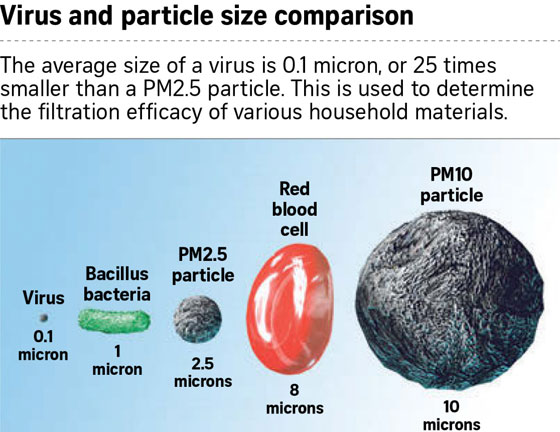Masking and microns. A virus can easily ‘squeeze through’ the pores of a surgical mask
For a mask to work, it needs to filter out particles. This requires that the pore size of the mask be smaller than the particles it is filtering. It also requires a tight fit: no leaks. If there is a bit of a charge on the mask that repels particles, as intended with new N95 masks, all the better.
See the particle size comparison in the diagram below:
Coronavirus: 0.1μm (the speck on the far left)
Pore size of N95: 0.1 -0.3 μm (0.1-0.3 microns)
Pore size of standard surgical mask: 0.3-10 μm
As you can see from the picture, aerosolized coronaviruses can easily squeeze through the pores in a surgical mask, which may have a diameter 100 times larger than a single virus.
But the bigger issue is the leaks, because the masks don’t fit snugly. It is almost impossible to both get a tight fit and be comfortable in a properly worn mask for more than a few minutes.
So instead we are wearing leaky masks that stop spit but don’t stop aerosolized viruses. What was told to the public early in the pandemic (and buried later) is that all the mask really does is stop you spitting at other people. It does not help the wearer much. Taking it on and off is a big contamination risk.
Remember the anthrax letters. Spores escaped through several layers of paper because the pores in the paper and envelopes were more than ten times larger than the diameter of the spores. The pores in the paper were as big as that boulder on the right, the same size as the pores in surgical masks. And coronaviruses are only one tenth as large as anthrax spores.
Wearing a mask outdoors is a joke. Wearing a mask indoors – well, if you want to be serious about masking, get yourself some N95 masks, get fit-tested, and use a new one each time you put it on. That would be a useful strategy. The rest is mostly wishful thinking.
yogaesoteric
September 7, 2021

